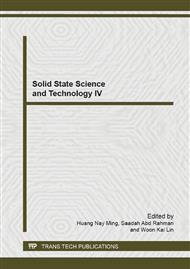[1]
J. L. Pang, L. Xu, X. Q. Shi, W. Zhou, and S. L. Ngoh, Intermetallic growth studies on Sn-Ag-Cu lead-free solder joints, Journal of Electronic Materials, vol. 33, pp.1219-1226, 2004/10/01 (2004).
DOI: 10.1007/s11664-004-0125-7
Google Scholar
[2]
K. N. Subramanian, A. Lee, S. Choi, and P. Sonje, Material issues in electronic interconnects and packaging, Journal of Electronic Materials, vol. 30, pp.372-378, 2001/04/01 (2001).
DOI: 10.1007/s11664-001-0046-7
Google Scholar
[3]
S. Terashima, Y. Kariya, T. Hosoi, and M. Tanaka, Effect of silver content on thermal fatigue life of Sn-xAg-0. 5Cu flip-chip interconnects, Journal of Electronic Materials, vol. 32, pp.1527-1533, 2003/12/01 (2003).
DOI: 10.1007/s11664-003-0125-z
Google Scholar
[4]
I. E. Anderson, J. C. Foley, B. A. Cook, J. Harringa, R. L. Terpstra, and O. Unal, Alloying effects in near-eutectic Sn-Ag-Cu solder alloys for improved microstructural stability, Journal of Electronic Materials, vol. 30, pp.1050-1059, 2001/09/01 (2001).
DOI: 10.1007/s11664-001-0129-5
Google Scholar
[5]
D. A. Shnawah, S. B. M. Said, M. F. M. Sabri, I. A. Badruddin, and F. X. Che, High-Reliability Low-Ag-Content Sn-Ag-Cu Solder Joints for Electronics Applications, Journal of Electronic Materials, vol. 41, pp.2631-2658, Sep (2012).
DOI: 10.1007/s11664-012-2145-z
Google Scholar
[6]
D. A. A. Shnawah, S. B. M. Said, M. F. M. Sabri, I. A. Badruddin, and F. X. Che, Microstructure, mechanical, and thermal properties of the Sn-1Ag-0. 5Cu solder alloy bearing Fe for electronics applications, Materials Science and Engineering a-Structural Materials Properties Microstructure and Processing, vol. 551, pp.160-168, Aug 15 (2012).
DOI: 10.1016/j.msea.2012.04.115
Google Scholar
[7]
D. A. A. Shnawah, S. B. M. Said, M. F. M. Sabri, I. A. Badruddin, and F. X. Che, Novel Fe-containing Sn-1Ag-0. 5Cu lead-free solder alloy with further enhanced elastic compliance and plastic energy dissipation ability for mobile products, Microelectronics Reliability, vol. 52, pp.2701-2708, Nov (2012).
DOI: 10.1016/j.microrel.2012.03.028
Google Scholar
[8]
E. ÇadIrlI, U. Böyük, H. Kaya, N. Maraşli, S. Aksöz, and Y. Ocak, Dependence of Electrical Resistivity on Temperature and Sn Content in Pb-Sn Solders, Journal of Electronic Materials, vol. 40, pp.195-200, 2011/02/01 (2011).
DOI: 10.1007/s11664-010-1425-8
Google Scholar


